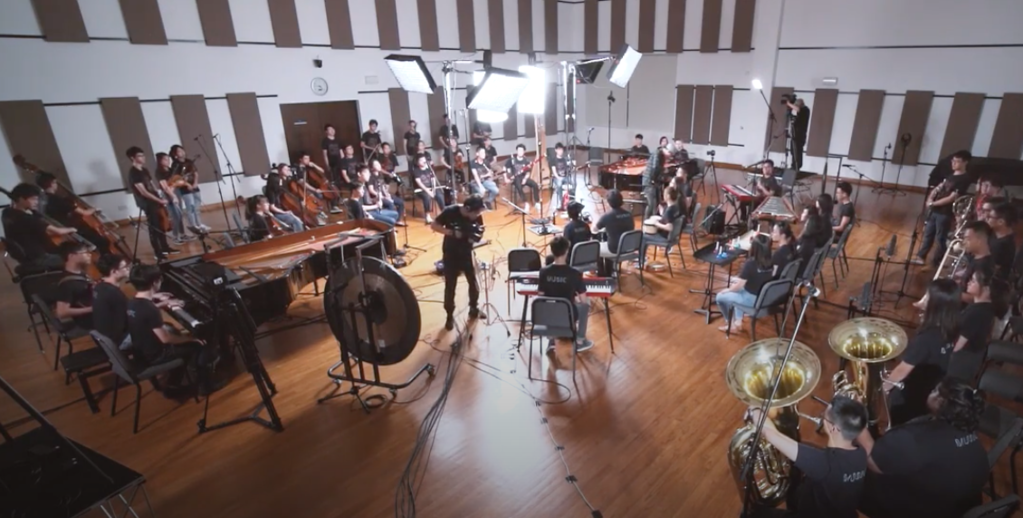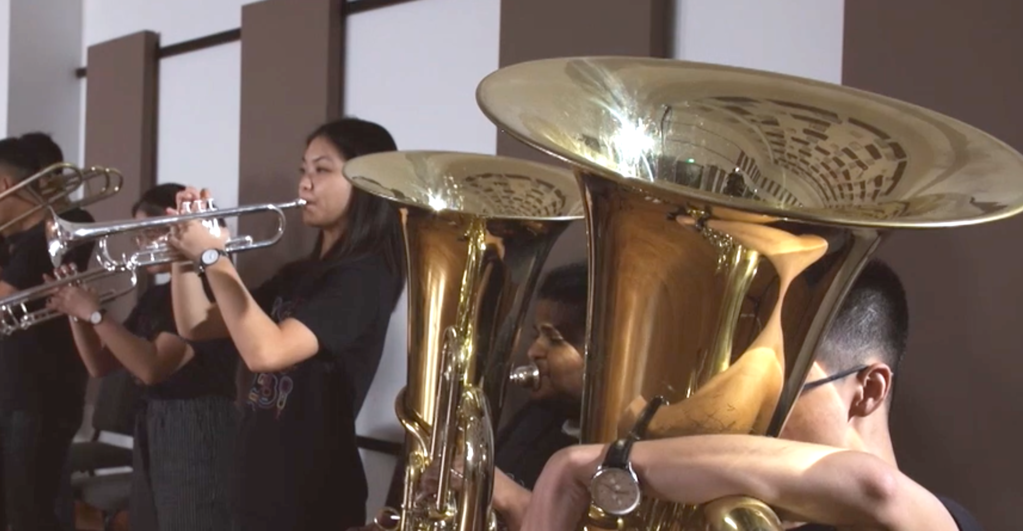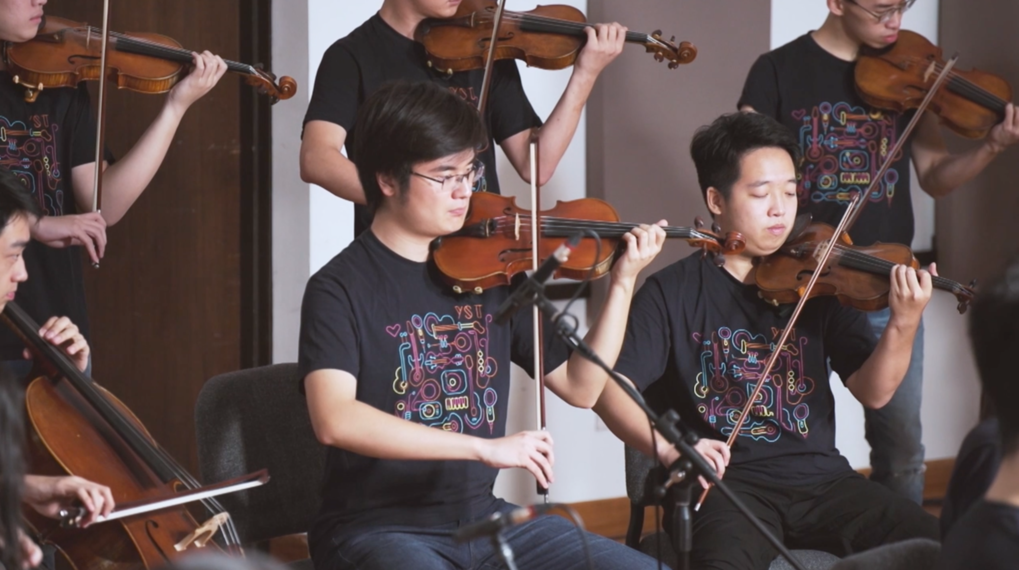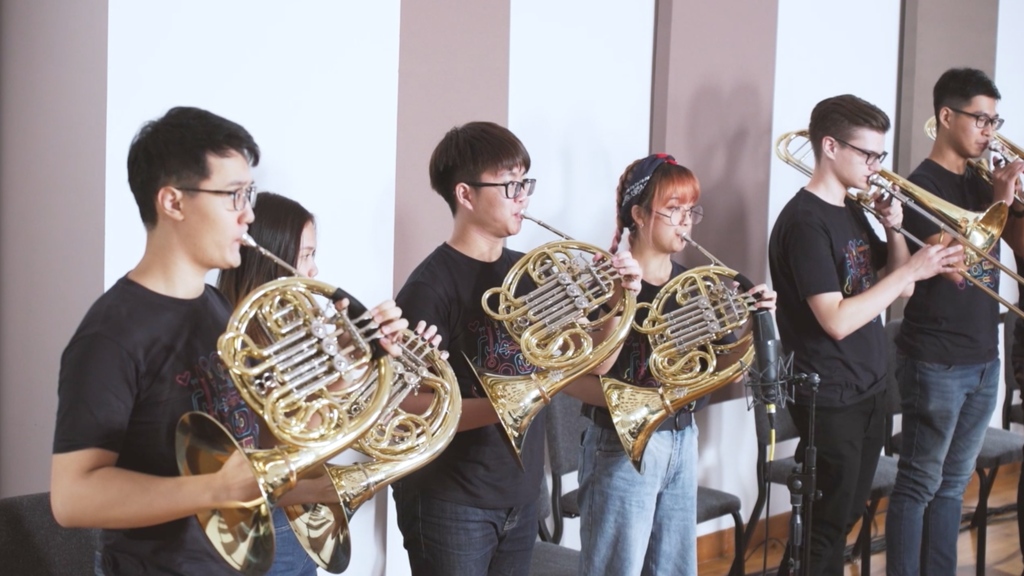FIRST YEAR CREATIVE PROJECT 2019
The creative project for all freshmen in 2019 was an evolution of the projects in previous years. Being involved in the projects of 2017 and 2018, I had a quite clear idea on the organisation and strategies to follow in order to achieve a result after working together for three consecutive days. These strategies had been developed in collaboration with Ty Constant and earlier on with Peter Edwards, both colleagues at YST Conservatory.
We started the first day with 56 new students who had already met and been involved in the general oriëntation phase of the university (NUS), but until now had never played together or heard each other play. Over the next three days they were challenged to create a piece from scratch, basically without writing anything down. After the three days they would have four days off and on the fifth day the piece had to be played in front of an audience during the opening concert of the school year. For this there was one general rehearsal planned on the morning of the concert.
The main working spaces available for the creation process were the Orchestra Hall (16x20m)1 for work with the full group, and 5 smaller studios for break-out sessions. ON the last day the Concert Hall is used, since this will be the space of the final performance. As much as possible the participants would play their main instruments, however this was not obligatory, and some students chose to play a percussive instrument instead, or combine different instruments.
STRATEGIES AND WORKING SCHEDULE
First of all it is important to create conditions where the students can freely invent and develop ideas without being directed too much, or told which musical materials to use. This is harder than it seems, since music students are so used to being told what to do. But it is important to avoid this and let the basic materials be invented in a collaborative setting without intervention. There are a few good reasons for this, which resonate with the goals YST is setting for itself as an institution. Most importantly the students should experience a sense of ownership, the feeling that they have come up with ideas that actually work within a larger whole. This can be anything from a thematic idea that gets picked up to a section of original music that fits somewhere in the final piece.
After a warming-up session on the first day we went straight to work. The main strategy to facilitate the creation process looks somewhat like a pyramid structure: starting by developing small ideas and working up to a larger whole. The steps in the process were as follows:
Day 1 (August 6)
• Division of the group into 6 smaller ensembles: jamming, improvising and creation of musical ideas and themes
• A round of presentations of the first ideas, discussion and selection of the best ideas and themes
• Merging 6 into 3 larger ensembles: further development of winning ideas
• Performance followed by discussion and reflection at the end of the day
Day 2 (August 7)
• Group work. Ideas from the sub-groups are being orchestrated on the fly to see how they can be developed within the large group. Things are being tried out and choices are being made on how to arrange certain sections. We
• Composition students and others who are interested interested think about the larger structure, what are the sections, the order, how do we begin and end?
• In the afternoon all work is done with the full group, work per section on orchestration, internal structure of sections, possible place for solos etc.
Day 3 (August 9)
• The full group moves to the Concert Hall for a first run-through.
• Discussion, is new material needed? Theatrical aspects, positioning, any movement in space?
• Second run-through, recording to take home.
The recording was provided to bridge the gap until the general rehearsal and final performance on August 14th.
IDEAS, SELECTION AND DEVELOPMENT
Without trying to be complete in any way I would like to present a few ideas and resulting sections of the piece, and discuss how they were conceived and developed. After the first half day of work the 6 above mentioned ensembles came up with rough materials. Quite a few ideas were groove based fragments with very generic and pop-like harmonic progressions. Melodies were not very original and most playing was loosely improvised on the chord progressions. However, there were also some more characteristic ideas, among which a quite contemporary sounding improvisation using the Shostakovich motif (D-Eb-C-B) and a little song using a 5-note Balinese Pelog scale. After reflecting with the group it was decided to form 3 new ensembles, one of them working further on the Shostakovich theme, one on the Balinese theme and the other to stay with the idea of a groove based part, but aiming to give it more character and substance.
With respect to coaching, up until this moment we did not do anything more than facilitating, and nudging here and there to let them play more and talk less. In the ensembles some students presented themselves as leaders, others were very inactive and had no idea what to do. We needed sometimes to give the weaker students more of a voice, and have them try to put into words what they were thinking and feeling. For nearly all students it was difficult to respond to what they were hearing, being so used to scores and achieving results by practice. As the ideas grew there was more need for tips and tricks: how to develop an idea, what are examples of things you can do with an idea?
THE SHOSTAKOVICH GROUP
This ensemble had a few very strong and creative students in it who quickly came up with different ways of using the Schostakovitch motif. They proposed to begin the piece by introducing the 4 note motif as a cluster, followed by a repeated version of the motif supported by a large crescendo in the full orchestra. With too many repeats there is the risk of boredom, so I challenge them to find a good moment and way to connect to a second idea, which is a waltz theme. The image on the right shows how it flows quite nicely from the Shostakovitch motif. Much time is spent on quite technical discussions about creating the music: extending of phrases, creating contrast, creating counterpoint voices, making a natural sounding transition between phrases and sections, creating logical harmonic structures, using imitation and canonic techniques, orchestrating and more.
THE BALI GROUP
The Bali group developed their ideas from an original song, brought in by one of the singers, who is from Indonesia. It uses the characteristic Pelog scale. The section developed quite naturally from the idea of using canonic techniques to create a harmonic dimension. One of the participants in the group had a strong background in harmonisation and brought an arrangement in that was taught to the others on the fly.
THE CUBA GROUP
The Cuban group consisted of two previous groups that had come up with a groove idea. One of their ideas was rejected and replaced by a simpler chord progression (I-ii-V) supported by a Cuban clave rhythm. Interesting for the process was that also non-percussionists decided to be part of the rhythm section, which was skillfully coached by Ty Constant. On this groove developed a cute song played on handbells divided over different players, reminiscent of a Muppet Show joke. In this batch of students there were quite a few interested in Jazz harmony. I challenged them to come up with supporting parts and think of the development of the groove. At some point the harmony changed to a four chord repetitive section where various students could try to play a solo. The best solos stayed in the piece. As an icing on the cake we discovered that a slightly altered version of the Shostakovitch motif could be used as a counterpoint for the violins for a further build-up of the groove.






